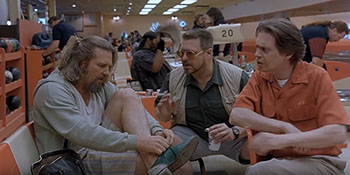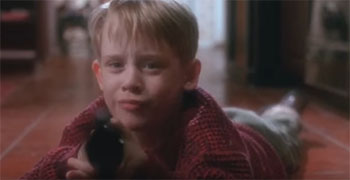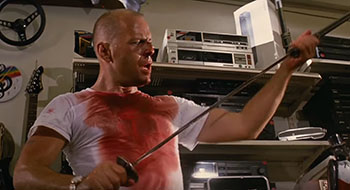6 Popular Fan Theories That Don't ACTUALLY Work

At their best, fan theories are a really fun way to look at a movie that you know inside and out. It doesn't matter if they're true or even come close to being true. A good fan theory takes a story that's been seemingly picked apart and reconstructs it in a way that's often cooler than the original story.
At their worst, however, they're a boring stoner telling you that The Lion King is secretly a prequel to The Dark Knight Rises, but only if you play it backward. Here are six of the most popular plug 'n' play fan theories that people seriously need to stop reverse engineering into literally every story ever told.
Everyone Is Tyler Durden
One of the film's leads can only be seen by another one of the film's leads. Maybe they're a hallucination or a ghost, or a hologram like Al in Quantum Leap. But it all adds up to essentially the same thing: imaginary friend.
When Someone Nailed It:
Your first exposure to this theory, maybe your first exposure to fan theories in general, was probably in connection with Ferris Bueller's Day Off. The movie conveniently parallels Fight Club with a repressed dweeb seeking liberation through mischief with the help of a walking, talking wish fulfillment. That theory says that Ferris never existed at all ... he was made up by Cameron.

This theory is the essence of what makes fan theories fun. The plot holes (Why are they taking attendance in class for a kid who doesn't exist?) will always be there, but the theory brings some of the movie's themes and subtext into the foreground, giving us a closer look at why Cameron finds Ferris so appealing. Cameron probably didn't imagine Ferris, but if Cameron did have an imaginary friend, that imaginary friend would be Ferris.
Why It Doesn't Work Everywhere Else:
This is probably the internet's favorite fan theory. The only ingredients needed are one character to be imaginary, and another character to imagine them. It's hard to find a movie, TV show, or video game that doesn't meet those qualifications. You only need two characters. The activities on the back of a box of Franken Berry provide all the evidence you need in order to theorize that Boo Berry is a manifestation of the immortal Count Chocula's survivor's guilt.
One iteration of this trope has it that Steve Buscemi's Donny from The Big Lebowski was really a ghost that fought alongside John Goodman's character, Walter, in Vietnam.

If this theory contributed anything worthwhile or showed us a different way of looking at Walter, maybe we'd be willing to try and overlook the fact that multiple people interact with Donny in the movie. Unlike Cameron, however, Walter is far from self-loathing. Unlike the narrator from Fight Club, he is anything but repressed. The biggest problem with the "Tyler Durden" is the fact that it's often shoved into a story with little thought as to the circumstances. Before you can add in a proper Tyler Durden, the character has to need a Tyler Durden.
The theory has been plugged into everything from Garfield to Rugrats and even back into Fight Club, which is about as arbitrary as theorizing that Tom Hanks was simply imagining Wilson the whole time.
The Villain Is The Hero!
You know the characters we've been following from the start who have made tremendous sacrifices to combat the overwhelming forces of evil? They were the real bad guys all along. The hero is actually that other guy. You know, the one who kidnaps princesses, blows up planets, and wears a human skull for a hat. In an alternate world, we're rooting for that asshole.
When Someone Nailed It:
This whole theory makes too much damn sense when it comes to Danny LaRusso in The Karate Kid. In his grudge with Johnny, it's he that throws the first punch and is solely responsible for escalating the conflict. He ultimately wins the karate tournament with a hard kick to the face, and Johnny has no issue with being the bigger man and handing the trophy over to his competitor. By any possible definition of the word, LaRusso is, in fact, the antagonist.

This take is less a "crazy theory that will TOTALLY CHANGE the way you watch The Karate Kid" as it is an examination of how the right theme song can trick you into rooting for literally anyone.
Why It Doesn't Work Everywhere Else:
Often, this theory is applied to movies and games where we don't know much about the villain, as that makes it way easier when it comes time to defend them. One that is particularly arbitrary, even by fan theory standards, suggests that the whole story of Mario, Princess Peach, and Bowser is a bunch of political propaganda cooked up to cast Bowser as the bad guy. In which case, even if this is just Princess Peach's media team cooking up some fake news (Sad.), Bowser is still the bad guy of the story.

Ask Bowser for his take on it and suddenly Peach was totally flirting with him and he was just about to seal the deal before Mario came and messed everything up. But even when you switch perspective, it usually becomes a way more underwhelming story. If Bowser is indeed the hero, he's a guy sending wave after wave of Koopas after a single plumber. He spends most of his sparse hero's journey presumably sitting in a chair. Mario, on the other hand, has to navigate an entire kingdom and slay countless foes to get to his goal. Sure, it's not a prerequisite that a fan theory has to make a story ten times more exciting, but it certainly helps your case when the bad guy does more than steal a princess and then nap for ten hours.
It Was All A Dream!
You know everything you just watched? Yeah, didn't happen.
When Someone Nailed It:
All too often, fan theories only make the movie more complicated. The Homer Simpson coma theory does precisely the opposite. It's actually the most simple, reasonable explanation for a show that plays fast and loose with continuity, characterization, and tone.
In the October 1992 episode "Homer The Heretic," Homer asks God the meaning of life. God tells him he'll find out when he dies. When Homer expresses impatience, God replies, "You can't wait six months?" Six months later, the April 1993 episode "So It's Come To This: A Simpsons Clip Show" has Homer crushed by a vending machine and falling into a coma. The theory has it that he never came out of that coma.
It kind of explains everything. What was once an emotionally grounded family sitcom with cartoony elements has devolved into Family Guy Without The Talking Dog. The show's increased disinterest in the integrity of its own characters is where we get the term Flanderization, because if anyone is going to be chiddily characterized by Homer Simpson's collapsing psydilly psyche, it's Ned Flanders.

Why It Doesn't Work Everywhere Else:
People love to bring this up when it comes to Breaking Bad's final episode, which had Walt imagining a more fitting ending while freezing to death in a car. Everything does seem to wrap up surprisingly neatly for Walter White through some elaborate Wile E. Coyote-esque scheming. He croaks, sure, but he croaks on his own terms, after rescuing Jesse and wasting all the neo-Nazis who screwed him over in the first place.
But ... how is that any different from a typical episode of Breaking Bad? Did we forget about the pipe bomb in the wheelchair? The super-magnet in the van? Saving Jesse with a bag of exploding rock candy? The only reason we never saw him enlisting Jesse to paint a tunnel on the side of a cliff is because showrunner Vince Gilligan never figured out a way to work it in organically.

And sure, Walt is a bad guy, and it would be weirdly satisfying for his character to go in a way that's karmically fitting. But it would also be a cop-out, as 99 percent of "It was all a dream!" stories are. They're ways to include some kind of narrative without fully committing to it. And those are disappointing 100 percent of the time.
This Character Grew Up To Be This Completely Different Character
You know those two characters with something (or nothing at all) in common? That's because they're totes the same dude, dude!
When Someone Nailed It:
That really might be James Bond in Michael Bay's action thriller The Rock. I mean, after all, it was Sean Connery himself who first pitched this theory, joking with interviewers that the film gave him a chance to play 007 one last time.
The backstories match up, with Connery's John Mason having a history as a British super-agent. And these properties mesh very nicely when it comes to tone, taking place in a world of heightened stakes where espionage has more to do with infiltration and superweapons than guessing someone's Gmail password over and over again. It certainly wouldn't be the first James-Bond-but-don't-tell-the-legal-department production. Hell, how likely are you to find a super-scientist named Goodspeed outside of the Bond-verse, anyway?
Why It Doesn't Work Everywhere Else:
One popular take on this theory has it that Kevin McCallister grew up to be Jigsaw from the Saw films, based on both characters' penchant for convoluted booby traps and nothing else. It's not the worst version of this theory we've seen, but why Kevin? Why not Mikey from The Goonies? Why not Pee-wee Herman? Why not Wallace? You also have to consider the age difference. Macaulay Culkin is way too old to play Jigsaw.

That kid is, like, 46.
Above all, the central problem with this theory is that It overlooks a big part of why fiction works on us in the first place. Maybe Jared Leto's Joker does remind you of Scut Farkus, but you know who else he reminds you of? That self-important kid your sister was dating last year.
Characters built on similar or overlapping archetypes will remind us of each other because that's what fictional characters are supposed to do. You watch Up and you can't help but imagine your own grandfather going on this adventure. You read Moby Dick and Captain Ahab's obsession with the whale reminds you of that time you spent a full month going back to the same YouTube comment thread to argue that the scat-rapping in the Red Hot Chili Peppers' "Soul To Squeeze" is vastly inferior to Mike Patton's scat-rapping in Faith No More's "Epic". I've just about got PigPorker1987 convinced.
When you pitch your secret identity theories, your dad's gonna say that you're watching too much TV. The truth is you're not watching nearly enough. If fiction doesn't remind us of other fiction, it doesn't remind us of real life, and it doesn't resonate.
The Story Is Secretly Set After The Apocalypse
The society in which the story takes place was built upon the ruins of another society ... sometimes the society featured in another story entirely.
When Someone Nailed It:
In the case of The Flintstones, the post-apocalypse theory imbues the show with an incredibly sad undertone. If the Flintstones survived, or descended from the survivors of a Cold War that went hot, that would explain why they celebrate Christmas in what is supposed to be a year ending in BC. It would explain why they have actual television sets alongside woolly mammoth showers, and why everything on the show looks like 1960's American suburbia, with the people of Bedrock doing the best they can to replicate the lives they knew before.

Why It Doesn't Work Everywhere Else:
The problem with this theory isn't so much that it's implausible as it is kind of like theorizing that Bruce Wayne is secretly a skeleton in disguise. Technically true but ... so what? Every civilization is built in the wake of another civilization. The Roman Empire, the longest lasting society in recorded history, ran for about 1,000 years, while large village settlements date back to around 6500 BC. So the concept of civilization has been around long enough to squeeze in almost six full Roman Empires.
If the apocalypse happened sorta recently, then the story has to be, on some level, survival in the wake of Armageddon. If the supposed apocalypse happened a long time ago, then it's a great big Who Cares? If another civilization has grown in the same place as the one that went extinct, what's the difference? Modern Italians don't call it post-apocalyptic Rome, they call it Rome, and then they kiss their fingertips for emphasis.

This theory is interesting when the previous civilization is echoed in some way within the new one, as in the Aladdin theory, what with the Genie's pop culture references. If your theory is only that the story's setting shares some Google Earth coordinates with a long gone civilization's, well ... duh.
Impossible Crossovers
These two stories, that have absolutely nothing in common, totally take place in the same universe.
When Someone Nailed It:
The theory that gets everyone really excited about connected universes is probably the E.T. theory, proposing that Star Wars is both true, and a legend that has been passed down in the E.T. universe. This explains those E.T. lookalikes appearing in the galactic senate and E.T. recognizing a boy wearing a Yoda mask. That's a good theory, but hardly mind blowing, so the shared universe theory we want to address is the proposition that Joel Schumacher's Batman Forever and Batman & Robin are, in fact, connected to Tim Burton's Batman and Batman Returns.

As with the Homer Simpson coma theory, this is one that reimagines a canon that went off the damn rails and figures out a way to stitch two disparate halves back together again. Not so much geeks inserting their hack fanfic into the canon as geeks trying to salvage something that used to be a lot better.
Why It Doesn't Work Everywhere Else:
Let's get one thing out of the way right up front: Shared brands ain't enough to go on for a crossover. Yes, they eat the same fake brand of potato chips at Paddy's Pub as they do at Greendale Community College. But the thing about the Let's-Potato-Chip-verse is it's just not a meaningful connection. On a similar note, Quentin Tarantino fans also like to connect Kill Bill and Pulp Fiction due to them both having swords in them ... which only seems like something you'd do if you'd never seen swords before.

A major issue with these shared brand theories is less about plausibility and more about whether or not they're all that interesting. If you tell me that all the big horror movies from the late '70s to today have been an epic saga chronicling the Necronomicon and climaxing with the apocalypse in Cabin In The Woods, that's a lot more interesting than people eating the same potato chips.
A lot of these crossover theories tend to mistake slight connections for full-blown Abbott And Costello Meet Frankenstein crossovers. Are samurai swords or potato chips that scarce of an artifact that they necessarily connect two worlds with little else in common? Does every single person in old-timey neckwear have to be a Time Lord? We're all drawing from the same collective subconscious here, and we're going to be treading the same territory in multiple stories. To mix and match every Gandalf and Dumbledore does a disservice to both of them.
Gilbert Smith is a writer, but what he really wants to do is direct silly little stop-motion cartoons.
For more check out 5 Horrifying Fan Theories That Make Way Too Much Sense and 5 Mind-Bending Fan Theories About Famous TV Shows.
Subscribe to our YouTube channel and check out 8 Great Movies Made Even Better By Fan Theories, and watch other videos you won't see on the site!
Also follow us on Facebook. We'll blow your mindhole.
It's Spring Break! You know what that means! Hot coeds getting loose on the beaches of Cancun and becoming imperiled in all classic beach slasher ways: Man-eating shark, school of piranhas, James Franco with dreadlocks. There are so many films about vacations gone wrong, it's a chore to wonder if there's even such a thing as a movie vacation gone right. Amity Island and Camp Crystal Lake are out. So what does that leave? The ship from Wall-E? Hawaii with the Brady Bunch? A road trip with famous curmudgeon Chevy Chase? On this month's live podcast Jack O'Brien and the Cracked staff are joined by some special guest comedians to figure out what would be the best vacation to take in a fictional universe.
Get your tickets here: